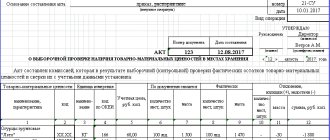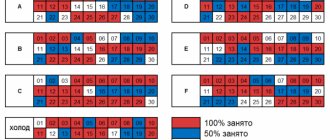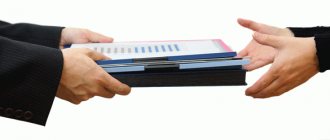Inventory structure
In order to guarantee the uninterrupted production process and satisfy managerial needs, companies form certain reserves, to control which the position outlined in today’s topic is used.
The latter refers to assets used as raw materials or materials during the production of goods for sale, as well as to meet the management needs of enterprises.
As for the tasks pursued from the point of view of inventory accounting, the following should be highlighted:
- control over the safety of inventory items in warehouses, as well as during their processing;
- ensuring the adequacy and timeliness of document flow for the movement of inventory items, determining and indicating the costs associated with their production, assessing the actual cost of used inventory items and their balances in warehouses, as well as on balance sheet items;
- constant monitoring of compliance with established inventory standards, as well as detection of surplus and unused inventory and their sale;
- ensuring the timeliness and completeness of settlements with contractors for supplied materials, as well as control over inventory items in transit.
Taking into account the role performed by certain PMZ in the production cycle, they should be divided into groups such as:
- base and raw materials;
- auxiliary raw materials;
- purchased semi-finished products;
- generated waste and fuel materials;
- components, containers and materials for its manufacture;
- household supplies and equipment.
As for the applied unit of measurement of PMZ, here, in addition to the nomenclature number, a batch, a homogeneous composition, etc. can be accepted.
Account 15 in accounting (“Procurement and acquisition of material assets”)
Inventories play one of the most important roles in the entire economic life of an organization. They are abbreviated as MPZ. Through their competent and rational accounting, it is possible to assess the real needs of the company.
The key task of using these elements is to ensure a smooth and uninterrupted commercial process, providing the enterprise with the necessary set of resources.
Composition of the MPZ
Absolutely every business entity periodically needs materials that can take part in the main production and be used to solve auxiliary tasks, including the management process.
, the following elements appear within the composition of the inventories :
- raw materials and basic materials;
- auxiliary materials;
- purchased semi-finished products;
- waste elements;
- fuel resources;
- container;
- spare parts;
- inventory;
- other supplies for business activities.
A significant part of these elements is used as labor tools. They are completely consumable and transfer their value to the price of the products that are produced.
Receipt of materials can be achieved through different methods , among the main routes are:
- the result of one’s own production labor;
- purchase from a supplier for a fee;
- free receipt of resources for use;
- receiving as a contribution;
- other variations.
It is permissible to take measures to account for materials received by the organization at the actual cost or at the accounting value. In the process of determining the actual price, purchase costs are taken into account. If an organization begins to use accounting prices, the use of subsidiary accounts is relevant.
Accounting procedure
For the purpose of rational planning of accounting work, the following accounting accounts :
- 10 – these are materials (with corresponding subaccounts);
- 11 – this account characterizes animals that are being raised and fattened;
- 15 – reflects the procurement and purchase of special material assets;
- 16 – we are talking about a probable deviation in the cost indicator of the MC;
- 41 – commodity items;
- 43 – manufactured products, ready for consumption.
As for the areas that are on the balance sheet, it is most often advisable to use the following accounts :
- 002 — goods and materials that are accepted for responsible storage;
- 003 – materials that were accepted by the enterprise for the purpose of subsequent processing;
- 004 – positions that were accepted for commission;
- invoice for special equipment transferred for use.
The accounting activities for this account are quite simple and understandable; several standard entries will be discussed below.
Legal framework and regulation of application
Accounting actions for inventive maintenance are regulated simultaneously at several levels of legislation. The highest of them is federal. It includes Federal Law No. 402 “On Accounting”, adopted on December 6, 2011, which came into force in 2013.
Within the framework of this law, general provisions of accounting regulations are established , as well as cumulative requirements. Regarding the MPZ, the law establishes the procedure in which primary documentation is compiled. In Art. 9 of the Law there is an establishment of mandatory details in the form of name, date, content, size, job titles, signatures.
Features of write-off, procurement and acquisition
Most often, in the course of commercial activities, enterprises account for inventories at book value, and the determination procedure may be as follows :
- the accounting value is taken as the price offered by the supplier in the process of selling the product item;
- the capitalization of inventories is carried out based on the cost of previous periods;
- The book price is a fixed amount agreed upon in advance.
If actual prices differ significantly from average market indicators, they are subject to mandatory revision. The use of accounting values in the process of determining the cost of inventories implies the practical use of account 15, which contains all the data on the actual purchase price.
Here are the main transactions that can be used during the operation of this account:
- Dt 15 Kt 16 assumes that the accepted accounting value exceeds the actual cost of the costs incurred;
- Dt 16 Kt 15 - this posting characterizes the opposite situation, in which the accounting value turns out to be less than the actual cost indicator.
It turns out that with the help of accounts 15 and 16 the difference between prices is reflected.
Typical wiring
All deviations from actual cost indicators ultimately affect cost accounts in the production process, these include 20, 26, 44 . a positive balance is accumulated , which is used in the process of generating a cost account.
If the accounting value is higher than the purchase price, a negative balance is formed on account 16 , which is reversed. According to the final description, the wiring will have the following form: Dt 20 (26, 44) Kt 16 .
The following is given : the company purchased 100 materials worth 30,000 rubles, VAT amounted to 18%. The accepted accounting value for this product group is 150 rubles. Question: what transactions will allow you to display these transactions, what amounts should be present in them?
- Dt 15 Kt 60 – goods were purchased. Transaction amount – cost excluding VAT: 30,000 – 30,000 * 0.18 = 34,600 rubles.
- Dt 19 Kt 60 – allocation of input value added tax. The amount is 5,400 rubles.
- Dt 60 Kt 51 – payment of materials to the supplier for a purchase amount of 30,000 rubles, i.e. the full purchase amount.
- Dt 68 Kt 19 – acceptance of input VAT for deduction, the posting amount is 5,400 rubles.
- Dt 26 Kt 10 - actual reflection of the cost of inventories in the expense areas of the enterprise.
- Dt 26 Kt 16 - writing off the amount of deviation of the actual cost as expenses.
- Dt 15 Kt 60 – purchase of commodity items that will subsequently be sold for 150 rubles. a piece.
- Dt 19 Kt 60 – allocation of input VAT amounting to 5,400 rubles.
- Dt 10 Kt 15 – receipt of materials to the warehouse at book value.
- Dt 15 Kt 16 - a reflection of the difference in prices.
- Dt 26 Kt 10 – reflection of the cost of inventories in expenditure areas.
Thus, this account is important in the process of all accounting activities and contributes to proper accounting of inventories. It has a large number of tasks and functions and contributes to the normalization of the commercial, economic, and production activities of the company.
Share with friends on social networks
Source: https://investim.info/schet-15-v-buhgalterskom-uchete-zagotovlenie-i-priobretenie-material-nyh-cennostey/
Features of inventory accounting
As practice shows, a company’s inventory can arrive at its warehouse as a result of their purchase, gratuitous receipt, or as a contribution to its authorized capital. Account 10 is used to keep records of this category of goods.
Thus, the cost of inventory items at the time of their delivery to the warehouse can be taken into account using the following methods:
- at the cost of goods and materials prevailing at the time of delivery. In the circumstances, position 10 applies;
- at the discount price, when the 15th position is additionally used to form the cost of these inventories.
It is recommended that the most preferred method of accounting for minimum wages be reflected in the organization’s accounting policies.
Methods of cost formation
A trading organization must choose a procedure for accounting for costs associated with the acquisition of goods. These costs can be:
– include in the actual cost of purchased goods;
– include in sales expenses (distribution costs).
Such rules are established by paragraph 13 of PBU 5/01.
Fix the decision made in the accounting policy for accounting purposes.
Costs associated with the purchase of goods include:
– costs of delivery of goods (loading, unloading, transportation);
– commission (intermediary) remuneration;
– other expenses, the appearance of which is due to the purchase of goods.
If the organization takes into account the costs associated with the purchase of goods in their cost, then reflect the receipt of goods with the following entries:
Debit 41 (15) Credit 60 (76)
– the receipt of goods at the contract price is reflected;
Debit 41 (15) Credit 60 (76)
– expenses associated with the purchase of goods are included in their cost.
This procedure is established by the Instructions for the chart of accounts (accounts 41, 15).
An example of reflecting transactions for the purchase of goods in accounting. The accounting policy of the organization stipulates that expenses associated with the purchase of goods are included in their cost
CJSC Alpha purchased 100 units of goods in the amount of 118,000 rubles. (including VAT – 18,000 rubles). To deliver goods to the warehouse, the organization used the services of a transport company. The cost of delivering goods to the organization’s warehouse amounted to 5,900 rubles. (including VAT - 900 rubles). According to the accounting policy for accounting purposes, the cost of goods is determined taking into account the expenses that arose during their acquisition.
The cost of all goods at which they were accepted for accounting was:
(118,000 rub. – 18,000 rub.) + (5,000 rub. – 900 rub.) = 105,000 rub.
The actual cost of one unit of goods was:
105,000 rub. : 100 pieces. = 1050 rub.
Upon receipt of the goods, the following entries were made:
Debit 41 Credit 60 – 100,000 rub. (RUB 118,000 – RUB 18,000) – reflects the contractual cost of purchased goods;
Debit 19 Credit 60 – 18,000 rub. – VAT on purchased goods is allocated;
Debit 41 Credit 60 – 5000 rub. (5900 rubles – 900 rubles) – attributed to the increase in the cost of goods and services for their delivery to the organization’s warehouse;
Debit 19 Credit 60 – 900 rub. – VAT is allocated for goods delivery services.
If the organization takes into account the costs associated with the purchase of goods in distribution costs, then reflect the receipt of goods with the following entries:
Debit 41 (15) Credit 60 (76)
– the receipt of goods at the contract price is reflected;
Debit 44 Credit 60 (76)
– expenses associated with the acquisition are taken into account as part of distribution costs.
This procedure is established by the Instructions for the chart of accounts.
Application of 15 accounts in transactions
When using item 15 to record transactions, its debit part reflects the purchase price of the company's inventory according to the settlement documents received from the supplier.
Taking into account the source of origin of goods and materials and the nature of the costs of their production and delivery, account 15 is debited in correspondence with 60, 76, 71, 20, 23 and other accounts.
At the time of actual receipt and capitalization of inventories, they are written off as credit 15 of the balance sheet position and debit of 10 or 41 accounts.
In a situation where the book price of inventory exceeds its actual cost, the difference in the indicated entry must be reversed. In this case, the entry will look like this:
Dt 16
Kt 15 reversible.
The debit balance of account 15 at the end of the reporting period indicates the existence of PMZ in transit. As for Form No. 1 of financial statements, the balance of account 15 at the end of the reporting period is transferred to line 1210. If we are talking about the purchase of equipment for installation, which is subsequently reflected in account 07, then the balance of item 15 should be reflected in line 1190 balance sheet.
Conditions for using the account
When registering material assets, an enterprise can use two methods:
- posting to account 10 “Materials”;
- application together with 10 accounts 15 and 16 “Deviations in the cost of material assets.”
Together with the count 15, the count 16 is necessarily used for arithmetic alignment.
The need for accounts 15 and 16 arises if the organization uses accounting prices, that is, those established by the organization itself. Discount prices can be set:
- at actual cost in the previous period;
- at independently developed planned prices;
- at the average price for the MPZ group;
- at negotiated prices (without technical specifications).
When choosing a method for setting prices, it is important to choose the one that will give the smallest deviation from the actual cost.
Practical examples and postings
Let's imagine a situation where a certain company purchased PMZ in the amount of 2,700 pieces for a total amount of 478,000 rubles, including VAT in the amount of 86,040 rubles. The receipt of materials was carried out at the book value of the inventory in the amount of 190 rubles. for 1 unit. To support the production process, the company wrote off 600 units of inventory.
In this situation, the accounting entries for account 15 should look like this:
- Dt 60 - Kt 51 - 478,000 rubles, settlements with the supplier for PMZ;
- Dt 15 - Kt 60 - 391,960 rubles, the actual cost of purchased inventories;
- Dt 19 - Kt 60 - 86,040 rubles, accounting for value added tax;
- Dt 10 - Kt 15 - 513,000 rubles, registration at the warehouse at book value;
- Dt 15 - Kt 16 - 35,000 rubles, write-off of the difference between the accounting and actual price;
- Dt 20 - Kt 10 - 114,000 rubles, write-off of inventory items into production;
- Dt 20 - Kt 16 - 7,777.78 rubles, write-off of the amount at the end of the reporting period.
Purpose and use
Account 16 is used to summarize information about the differences that have arisen between the values of acquired material assets.
They are calculated within the framework of the actual cost of procurement or purchase, as well as accounting prices. It is used by enterprises that account for materials on account 10, and also use low-value items with immediate wear and tear by reflecting them on account 12 at accounting values.
The amounts of differences in the costs of acquired assets, calculated in the actual costs of purchase and procurement, as well as accounting prices, are subject to write-off to the Debit or Credit of account 16 from account 15 “Procurement and acquisition of materials”. Such valuables may include the following product items and units:
- fuel resources;
- mineral fertilizers;
- stern;
- seeds;
- planting materials;
- construction equipment, etc.
The differences accumulated in the account relating to the cost of acquired assets are written off to the debit of accounts related to the accounting of production costs, as well as other areas in proportion to the values at the accounting prices of materials used in the production process.
Analytical accounting activities within the framework of this account are carried out for groups of material resources with approximately the same degree of deviations.
Thus, it turns out that account 16 is traditionally used to account for the difference between the accounting value and the actual cost of inventories. This direction is often used by organizations that reflect the value of inventories within the framework of accounting values. Traditionally, they take into account the purchase of material and production assets using account 15.
Procedure for distribution of expenses
Trade organizations usually distribute only transportation costs associated with the delivery of goods to the organization’s warehouse (clause 228 of the Methodological Instructions, approved by Order of the Ministry of Finance of Russia dated December 28, 2001 No. 119n, Instructions for the chart of accounts). By the way, with this approach, an organization can avoid differences between accounting and tax accounting data, in which such a procedure for allocating expenses is mandatory (Article 320 of the Tax Code of the Russian Federation).
When distributing, use the following order.
1. Determine the average percentage of transportation costs:
| Average percentage of transport costs | = | Transport costs related to the balance of unsold goods at the beginning of the month + Transport costs incurred during the month _______________________________________________________________________ | × | 100% |
| Cost of acquisition of goods sold in the current month + Cost of acquisition of goods not sold at the end of the month |
2. Determine the amount of transportation costs related to the balance of unsold goods at the end of the month:
| Transportation costs related to the balance of unsold goods at the end of the month | = | Average percentage of transport costs | × | Cost of goods not sold at the end of the month |
3. Determine the amount of transportation costs related to the amount of goods sold, which will be included in the cost of goods sold for this month:
| Transportation costs related to goods sold for the month | = | Transportation costs related to the balance of unsold goods at the beginning of the month | + | Transport expenses incurred per month | – | Transportation costs related to the balance of unsold goods at the end of the month |
To apply this procedure, fix it in the accounting policy for accounting purposes (clause 228 of the Methodological Instructions, approved by Order of the Ministry of Finance of Russia dated December 28, 2001 No. 119n).
Methods for writing off expenses
Expenses associated with the purchase of goods can be written off to cost of sales in two ways:
– in full in the reporting period in which they were incurred;
– partially with distribution between goods sold in the reporting period and their balance.
The second option for writing off expenses allows you to more evenly form the cost of sales. Therefore, it is recommended for organizations:
– with a seasonal nature of activity;
– in which the share of expenses associated with the purchase of goods exceeds 10 percent of revenue.
Such rules are established by paragraph 228 of the Methodological Instructions, approved by Order of the Ministry of Finance of Russia dated December 28, 2001 No. 119n.








